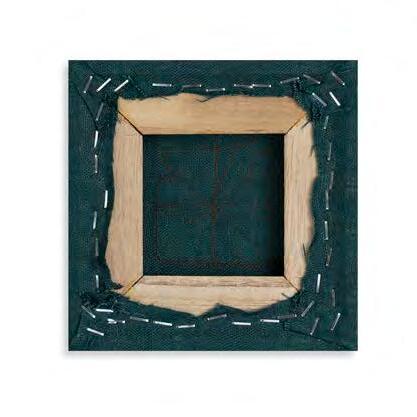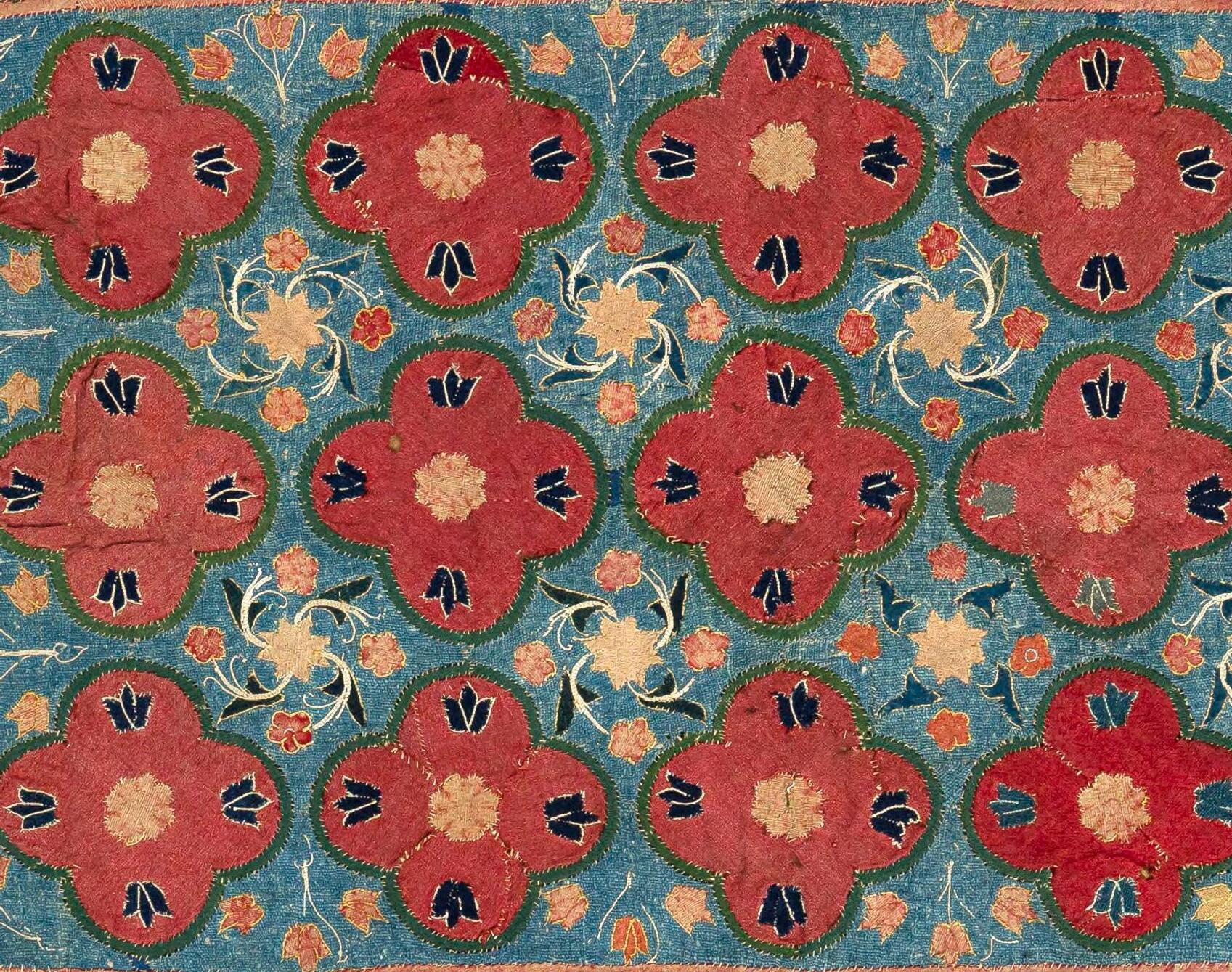

FALL/WINTER CATALOG
To all our friends, clients, admirers of antique textiles and everyone else, we sincerely wish you a great holiday season and a Happy New Year.
Attached for your browsing is our winter catalog with some rare finds
Enjoy, Yosi
Contact: yosi@sarajo.com (646) 258-3727 www.sarajo.com instagram.com/sarajo.inc
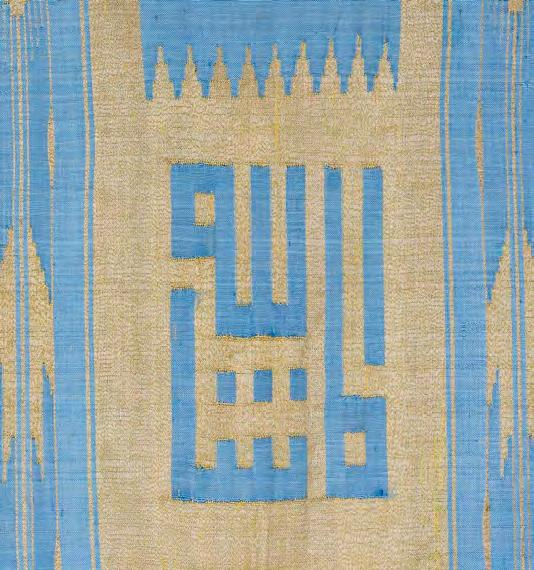
BORO JACKET
Natural wear is considered beautiful in Japan. Wabi-sabi is the Japanese philosophy of appreciation of the imperfect. Developed out of necessity, it is manifested in various mediums such as pottery repaired with gold, which is called Kintsugi or mended, patched and re woven cotton household textiles and clothing articles which is called Boro.
Boro developed out of the lower classes need for inexpensive textiles. Using scraps of material of similar color, usually indigo dyed and often patterned cotton and layering them by sashiko stitching (running stitch) resulted in complex and many layered patchwork clothing or household items that often lasted for generations. Appreciated for their beauty, Boro textiles are also practical, providing warmth by their layering.
ORIGIN Japan
PERIOD
19th century
MATERIAL
Layered cotton, mended and patched
SIZE
31” x 48”
CONDITION
Stabilized wear throughout PRICE
$2,400
INVENTORY #
NS0031




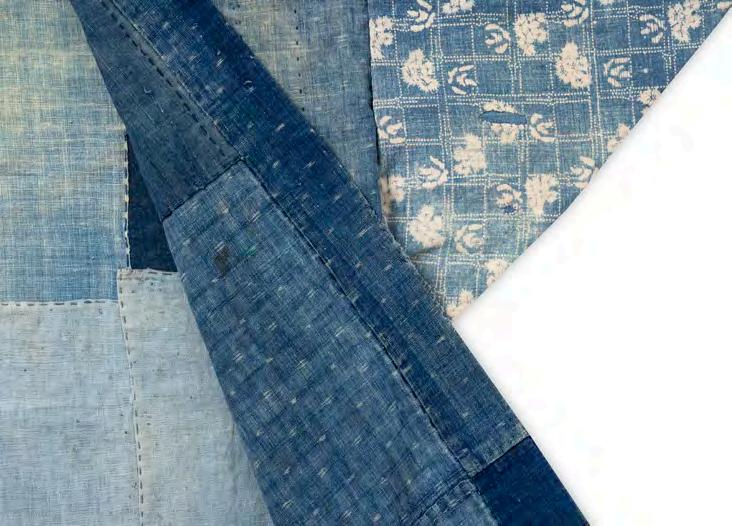
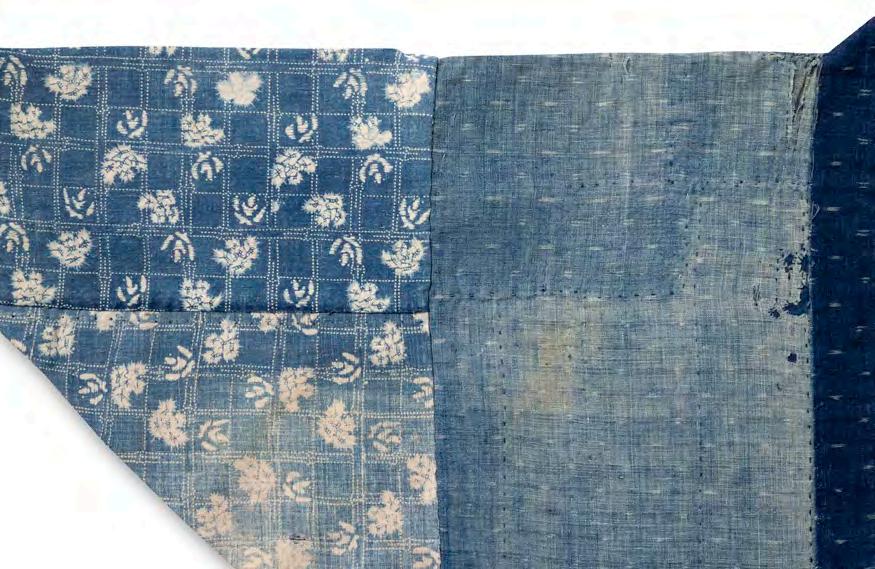

VIETNAMESE EMBROIDERY FRAGMENT
Embroidery arrived relatively late in Vietnam, dating to the 15th century when a mandarin returning from China introduced it to palace workshops. It is similar to Chinese embroidery with minor differences in the coloring which is more complex and drawing which has sharper lines.
One of the distinguishing features of Korean embroidery is the prevalent usage of couching technique to give it a third dimension. Couching technique, which is widely used in different parts of the world, is a method of attaching the embroidery threads to the ground fabric without having to go through the ground with threads that are too thick, too textured or too fragile. Threads, chords or even shaped pieces of cardboard are laid on top of the fabric and anchored to it with much finer threads that do not damage the ground and often are almost invisible.
In this fragment, likely part of a large wall hanging, the couching is employed on the bird and all the flowers, leaves and branches. It raises the body of the bird by a quarter of an inch. The anchoring threads are attached with very fine chain stitch silk to a satin ground.
ORIGIN Korea
PERIOD
19th century
MATERIAL
Silk embroidery on silk
10” x 57”
CONDITION
Fragmentary condition with minor fraying along the edges

INVENTORY #
NS0017
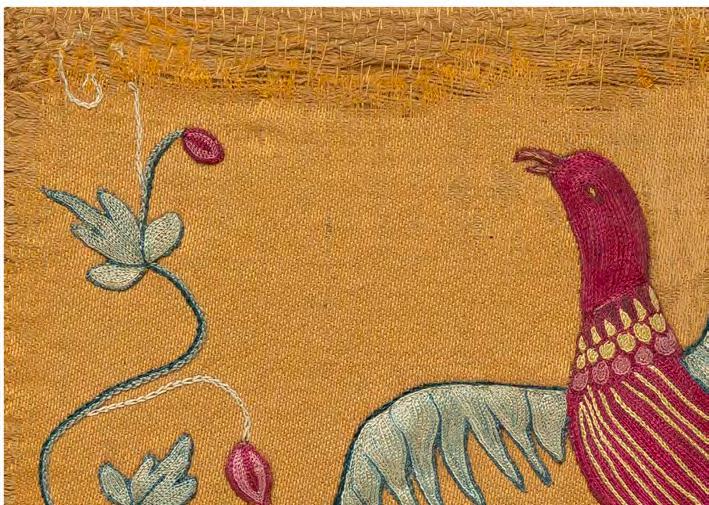
DISTRESSED AREA

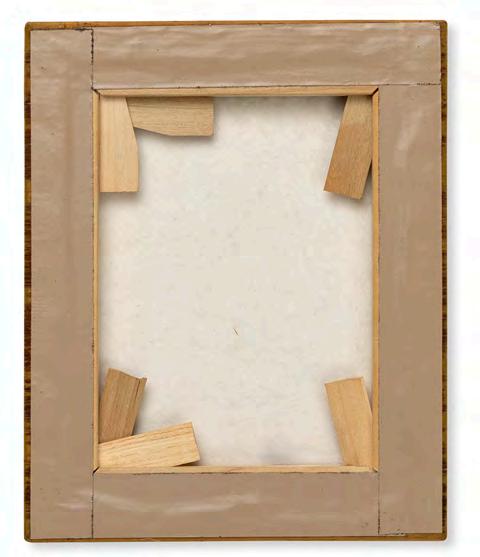
MARU OBI
An Obi is the belt used to tie a kimono. Obi have evolved from the 17th century when it was thin, ribbonlike and functional into the 20th century when it has become stiff, wide and impossible to tie by oneself. Later Obis do not function as belts anymore but rather conceal the Koshihimo which is a series of ties to secure the kimono in place.
Maru Obi is the most formal of Obis, worn by brides and apprentice Geishas. It is fully patterned, folded around a double lining, bulky and heavy.
This Obi is a Nishijin-Ori as it is from the Nishijin district of Kyoto, an area famous for high quality brocade production. Its design features a black lattice enclosing Irises and Chrysanthemums, flowers associated with the imperial family that bestow longevity, protection and rejuvenation on the wearer, all against a gold background.
ORIGIN
Kyoto, Japan
PERIOD Late 19th century MATERIAL
x 13”


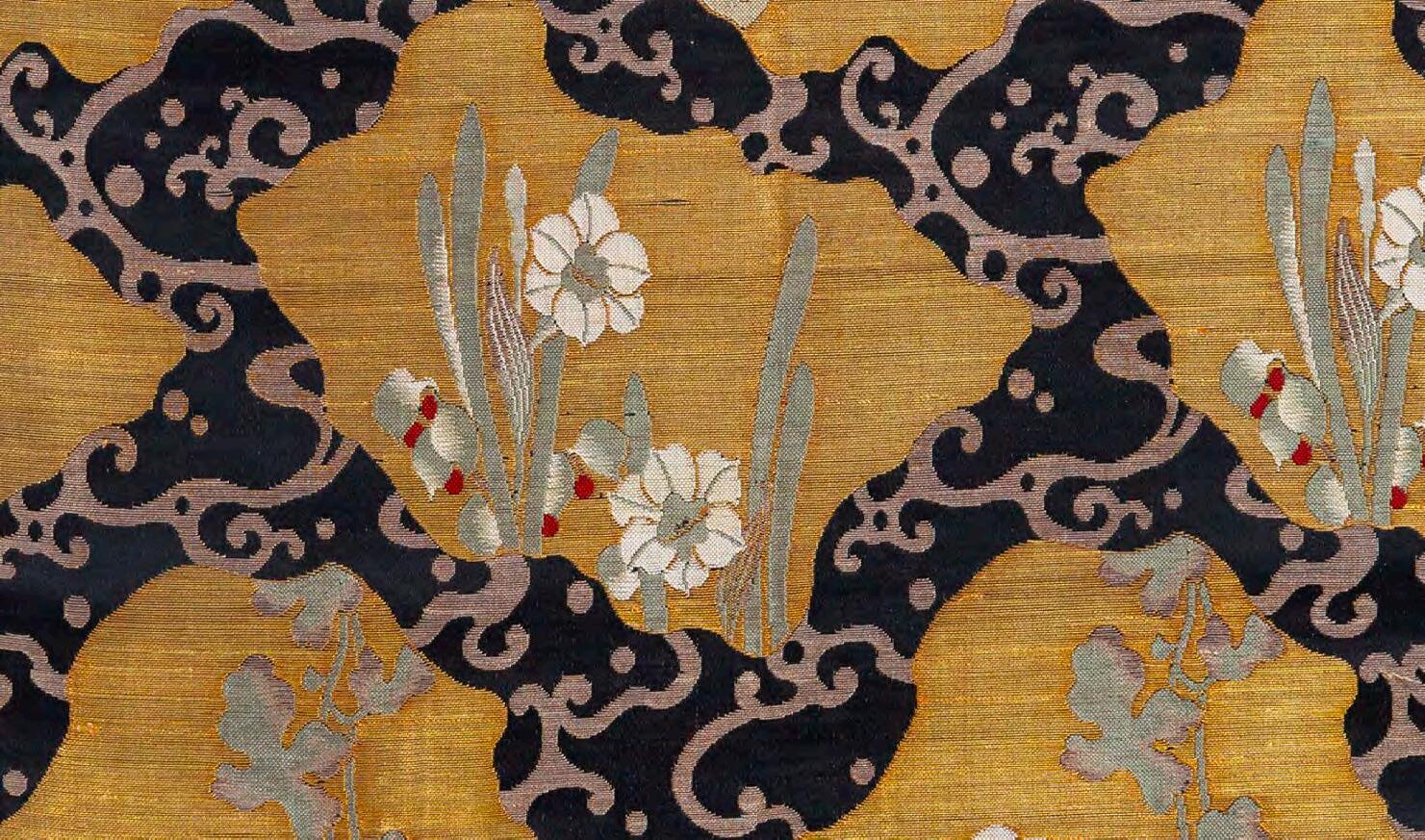
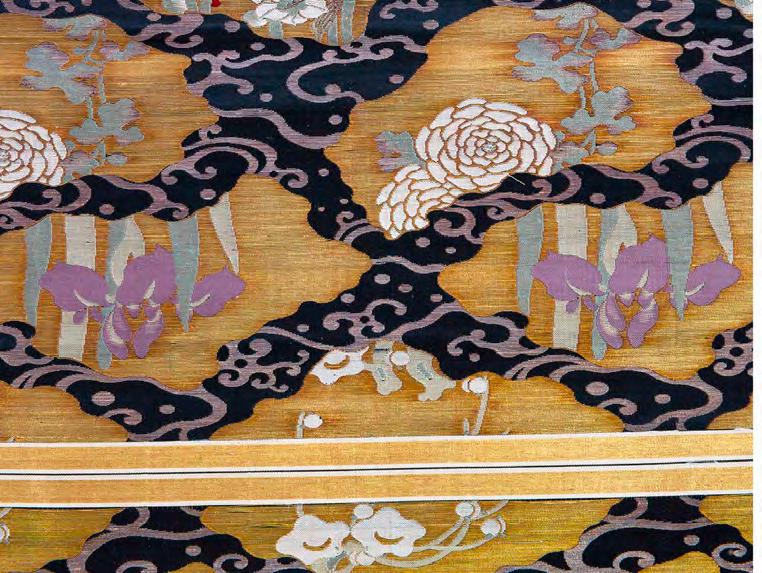
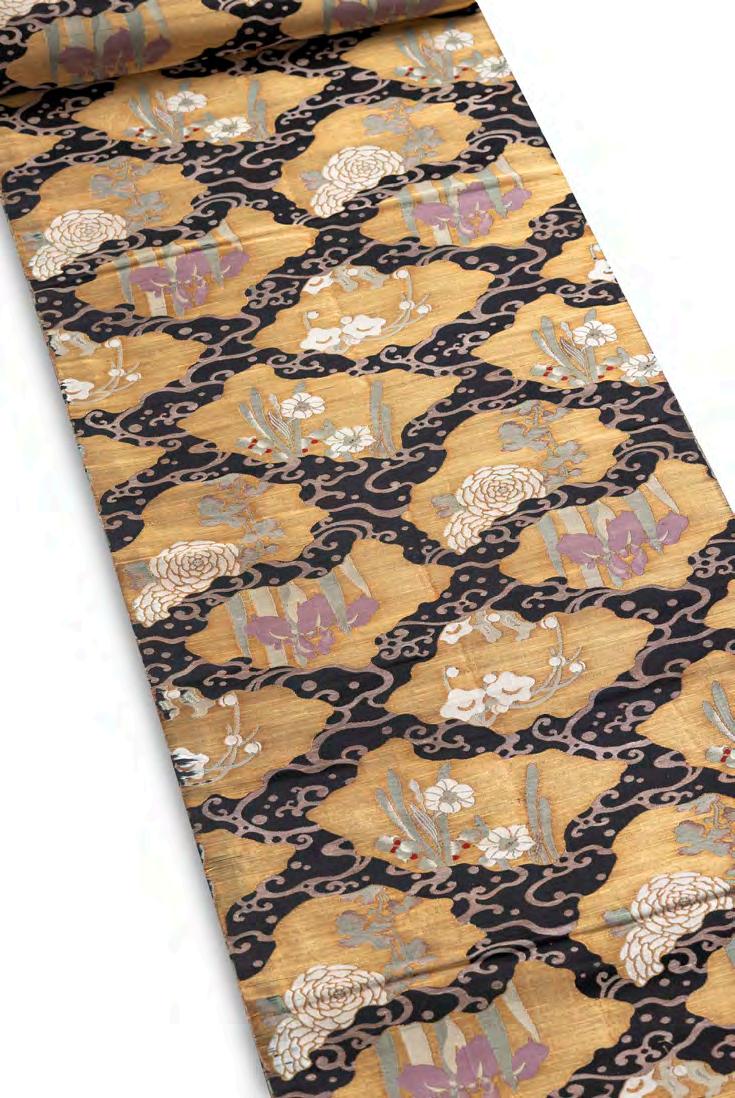
ALGERIAN MERCHANT SAMPLE
Algerian Berbers’ hand weaving tradition used to be as vibrant and extensive as its Moroccan neighbor’s. That has changed in the 20th century with independence and the political instability that ensued. Algerian weaving tradition is similar to Moroccan and Tunisian, and it is primarily a woman’s job.
This diminutive weave has three white center fields that are separated by five stripes of dense linear geometric all applied in a discontinuous supplementary weft.
This small and tightly woven piece resembles a typical Ddil, a woman’s body wrap of the Kabyle Berbers. The unusual small size indicates it was made to be used as a merchant’s sample.
15.5” x 59” without tassels
15.5” x 77” with tassels CONDITION
Minor repairs visible on the reverse
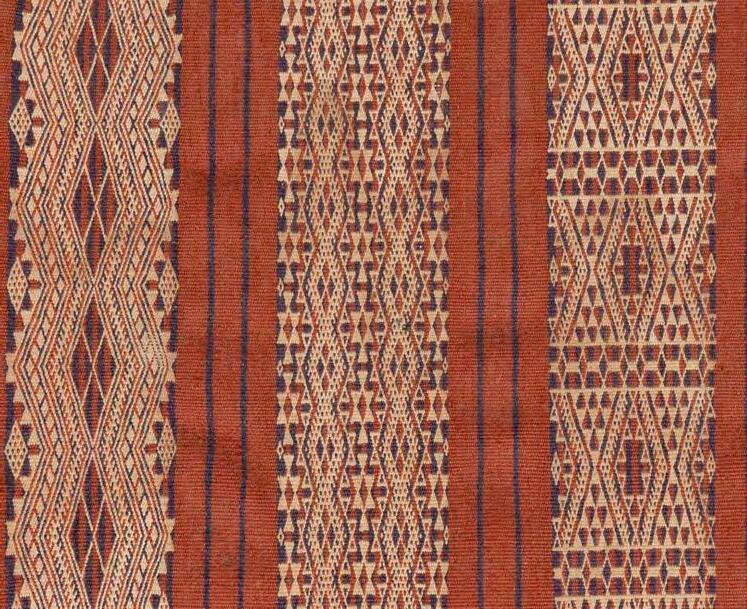


DISTRESSED AREA

BUCHARA SUZANI
Suzanis, the large embroideries of Central Asia are strikingly decorative yet utilitarian. They fulfil multiple purposes for nomadic people, created to be used in tents as hangings, prayer mats, bed covers, sheets or covers for beddings and kitchen equipment.
They are made by the bride and other females of her family and presented to the groom as part of the dowry. Their design is drawn on cotton or silk strips (six of them here) and each embroiderer works on one strip. When they are stitched together, they result in an off register and variety of hues, all adding to their irreverent beauty.
Most suzanis were made in Uzbekistan and can be categorized by their design to different cities. Buchara suzanis usually feature vines of serrated leaves and lattices of red hued rosettes, just like this fine example. In the borders here the rosettes alternate with central smaller rosettes from which four more flowers emerge.
Suzanis are essentially power objects, offering protection and strength. Their tribal motifs symbolize luck, health, long life and fertility.
ORIGIN
Buchara, Uzbekistan
PERIOD
Mid 19th century
MATERIAL
Silk embroidery on cotton
88” x 68”
CONDITION
Minor loss to black embroidery yarn, stain and repaired area to backing
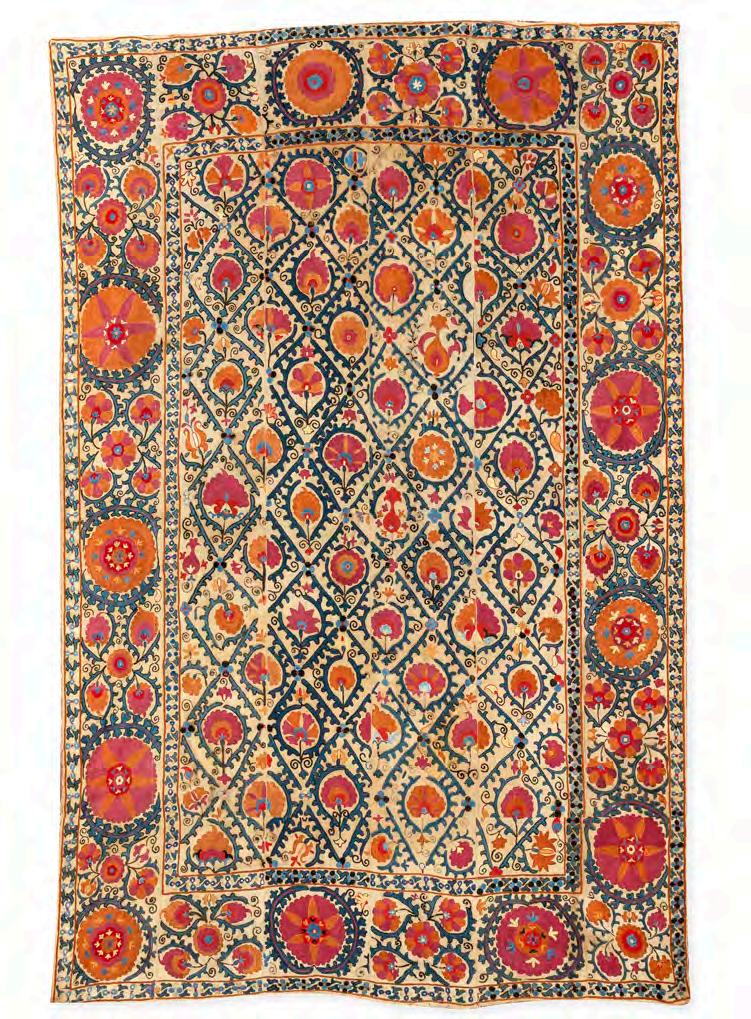
INVENTORY #
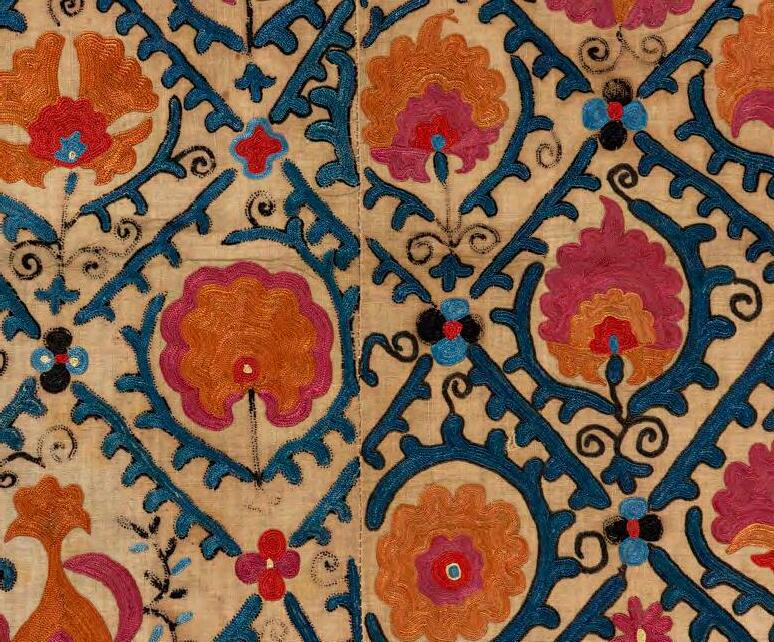
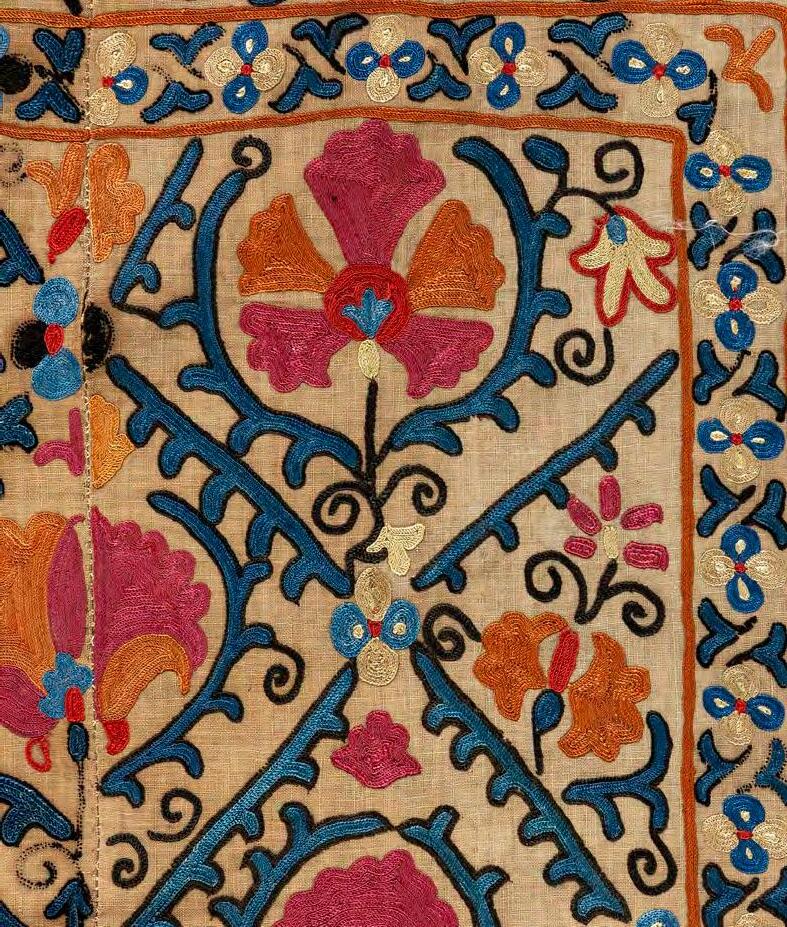
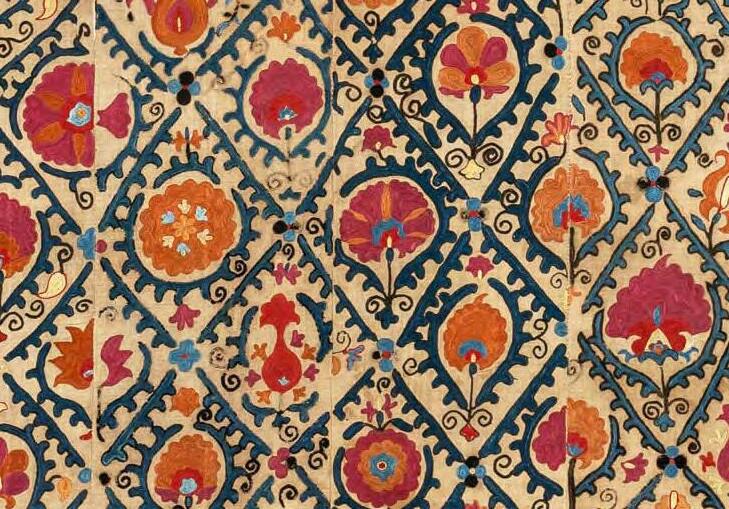


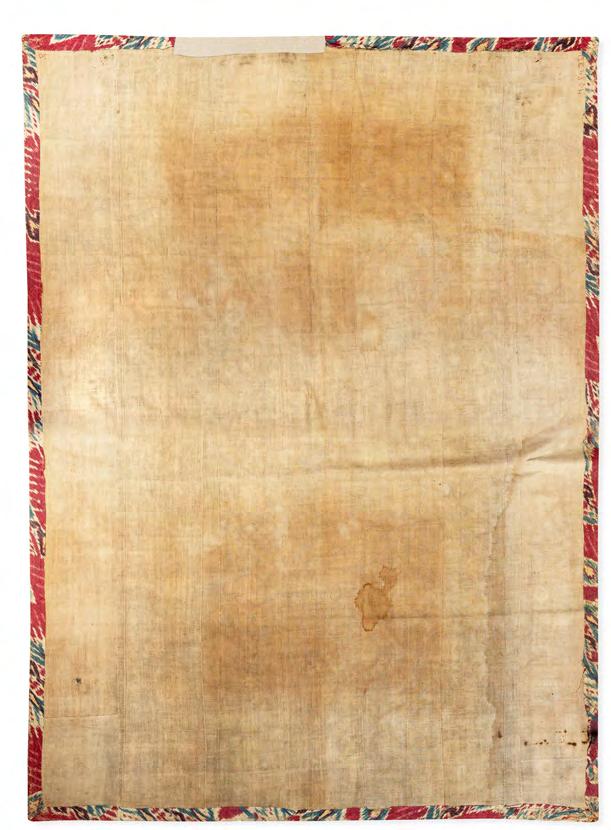
REVERSE VIEW
HUARI TUNIC FRAGMENT
The Huari of Peru were the dominant culture of the region from the 5th trough the 11th century. Originally farmers with a strong military tradition, they imposed their language and culture on their neighbours.
As their upper class were buried with belongings to carry into the afterlife a lot has been preserved to attest to their rich and distinctive artistic tradition. Ceramics, metalwork and textiles were all fields in which they excelled, and all three areas show the Huaris penchant for high abstraction. The reasons for this are not clear and could be either resulting from drug induced trance consciousness or an attempt by the upper classes to force their aesthetics by denying commoners access to their logic.Their textiles, include tapestries, tunics and hats and they are all distinguished by their vivid and contrasting colors. Their designs are mostly grid oriented and their motifs are a select few; frontal faces, profile faces, skulls, animals, figures wearing tunics or bearing a staff, and stepped diamonds, triangles or frets.
Huari textiles are exquisitely crafted and while patchwork is common, their interlockedtapestry woven textiles with their high-density thread count is the most awe inspiring.
This rectangular fragment is one of two front pieces of a tunic. They should be attached to a larger square back. Motifs include faces in profile and stepped triangles. All in still vivid colors and in splendid condition.
ORIGIN Peru
PERIOD Circa 800 AD MATERIAL
Camelid fibers SIZE
9” x 21” mounted on 13” x 26” frame
CONDITION
Fragmentary good condition
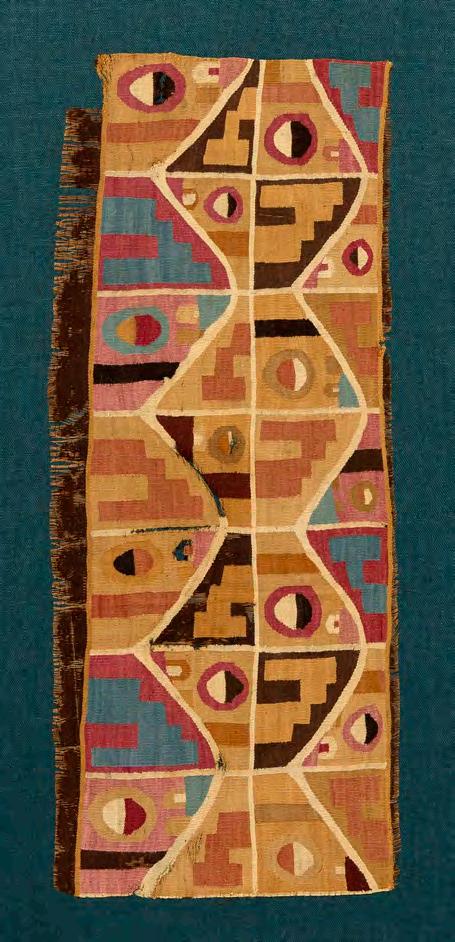
INVENTORY #
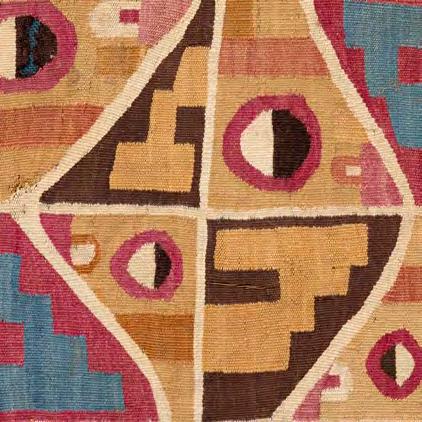


PAISLEY SHAWL FRAGMENT
Kashmir shawls can be traced to 13th century India where they were used as a covering for upper class men. Their design features a droplet shape motif called Boteh.
Their production is the very labor-intensive technique of twill tapestry called Kani and it involves using a large number of bobbins, each loaded with a yarn of different color instead of a shuttle.
In the 18th century with flourishing trade between Europe and Asia they became sought after by wealthy, fashionable and most often royal Europeans. As demand increased production moved to Western Europe and became more mechanical, using Jacquard looms and standardized designs. The European shawls weren’t the fine quality of their Indian ancestors, but they weren’t as expensive. They were worn by European women till the 1870’s when the bustle became fashionable, rendering them obsolete.
The European town producing the best shawls was Paisley, just outside Glasgow in Scotland and eventually all European shawls were called Paisleys. Dating them can be done according to the boteh shape, its content and the urns they sprout from.
x 56”
Fragmentary, delicate but stabilized. Good condition.
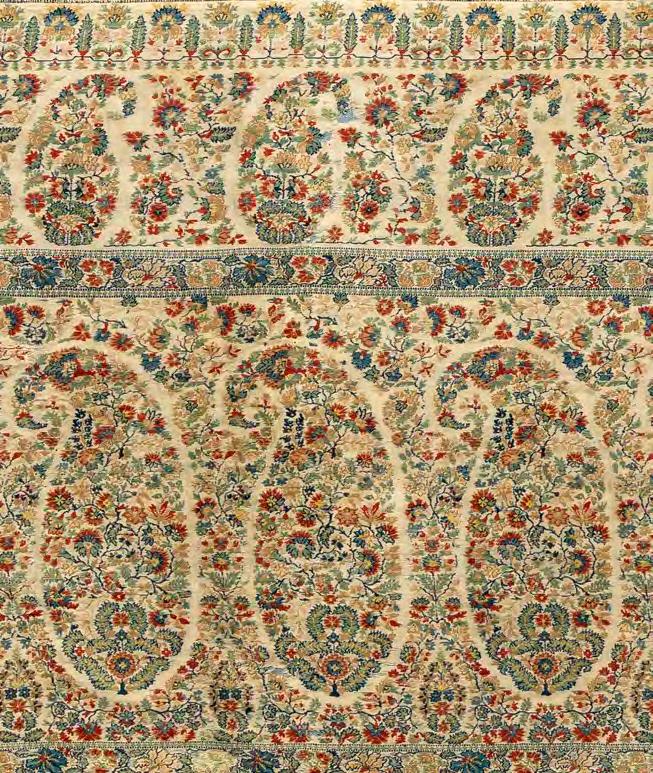
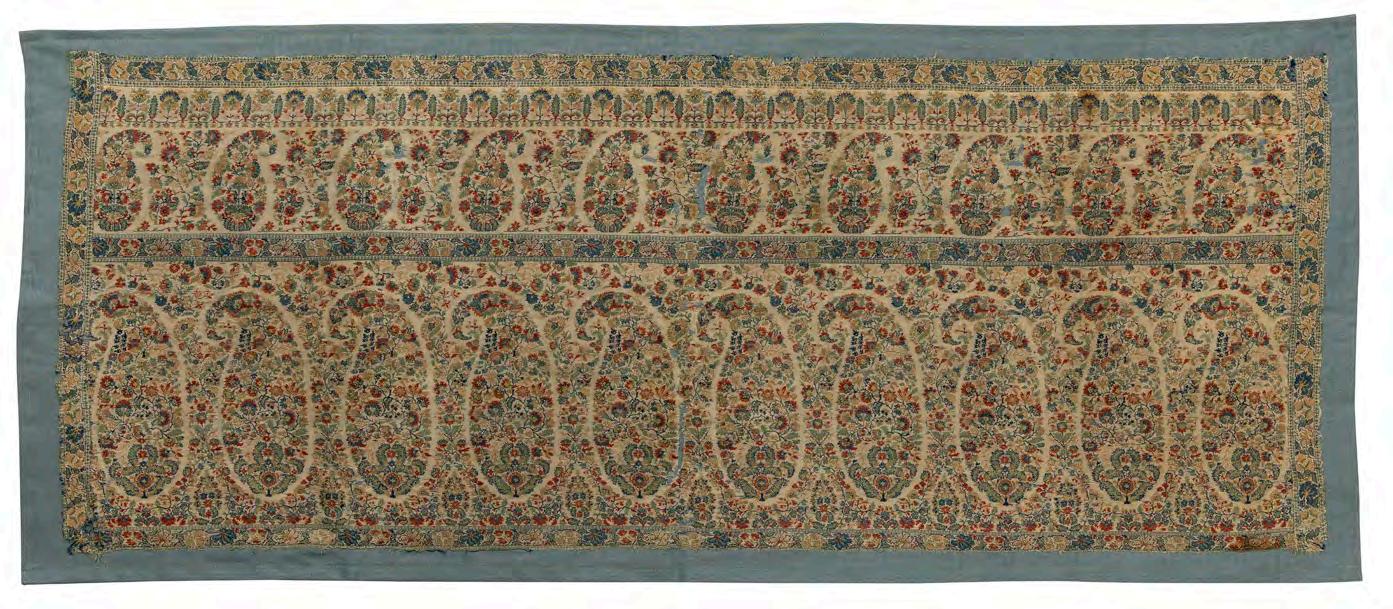


DISTRESSED AREA
NAQADAH ABA
Nakadah is an Egyptian town south of Cairo on the West Bank of the Nile. Textile production there goes back to the second millennium BC. The weaving has always been done by women on traditional looms, but the textiles produced have evolved according to the targeted markets. In the 18th and 19th centuries the town produced modesty garments worn by married women and abas, the sleeveless silk or wool robes worn by upper class men. These garments were exported along the cross Saharan caravan roads to the oases of western Egypt as well as to Libya, Tunisian, Algeria and Morocco.
Demand for abas waned in the mid 20th century as cross Saharan routes were hindered by political unrest and replaced by seafaring trade. Consequently, Nakadah textile production adapted by using the same patterns but on bright, shiny and colorful rayon cloth that appeals to the Sudanese market.
Not as famous for their quality compared to what came out of the Syrian weaving centers of Damascus and Aleppo, some of the work is quite accomplished as is evident is this aba. It is made of silk and metallic thread in slit tapestry technique. The design scheme is generally linear with a stylized Inchallah, or God’s willing, across the top of the backside.
ORIGIN
Naqadah, Egypt
PERIOD
Late 19th century
MATERIAL
Silk and metallic thread SIZE
54” x 53”
CONDITION
Very light tarnishing, excellent condition

INVENTORY #
NS0026
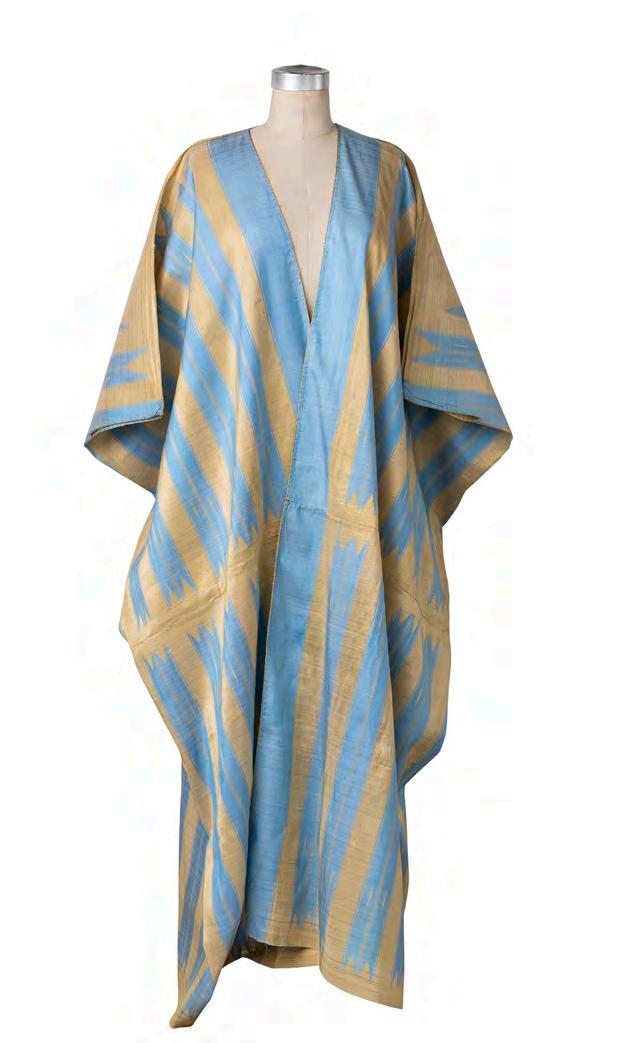
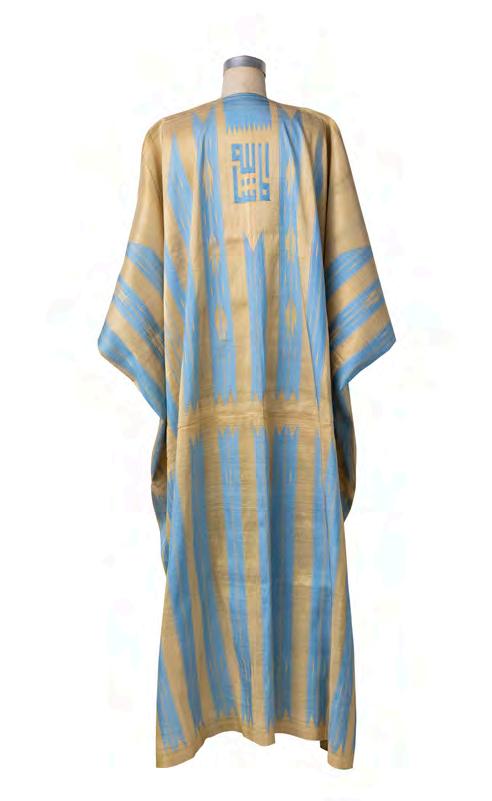


EPIRUS CURTAIN FRAGMENT
Epirus is part of mainland Greece, but its embroideries are unlike the work done elsewhere in mainland Greece and other neighboring Balkan countries. On the other hand, Epirus embroideries have a lot in common with Greek Island embroideries, particularly Skyros work, therefore it makes sense to deal with them in this context.
Epirus was the largest textile Center in the Balkans, producing uniforms and court garments for most of the Balkan countries all the way to Hungary as well as Anatolia.
It also produced lovely embroideries that were either floral or figurative with people, birds, animals and botanical themes. These embroideries were very detailed, including facial and dress specifics. The fashion details enable to determine the age of the embroideries. Embroideries for ritual sheets were done along the edges, and the unadorned center was replaced through generations of usage.
This fragment, most likely part of a curtain features a large antlered deer, typically to Epirus work with dotted hide. It is surrounded by smaller deer, birds, stars and flowers. Selvedged sides and meandering borders on three sides indicate a vertical scheme. Polychrome silk split stitch on linen.
ORIGIN
Epirus, Greece
PERIOD 18th century
MATERIAL Silk embroidery on linen SIZE
19” x 17”
CONDITION
One 2” x 3” hole bottom center, minor stains, fair condition
PRICE POR
INVENTORY #
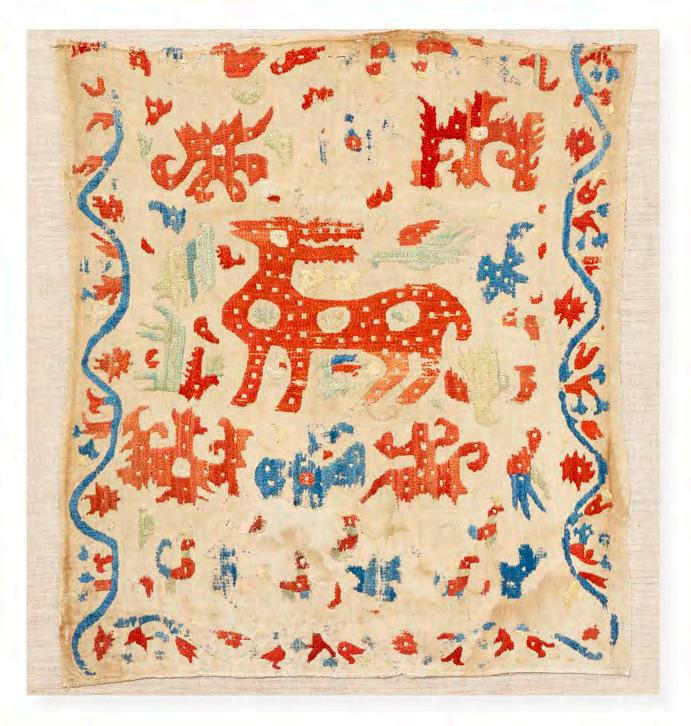


DISTRESSED AREA
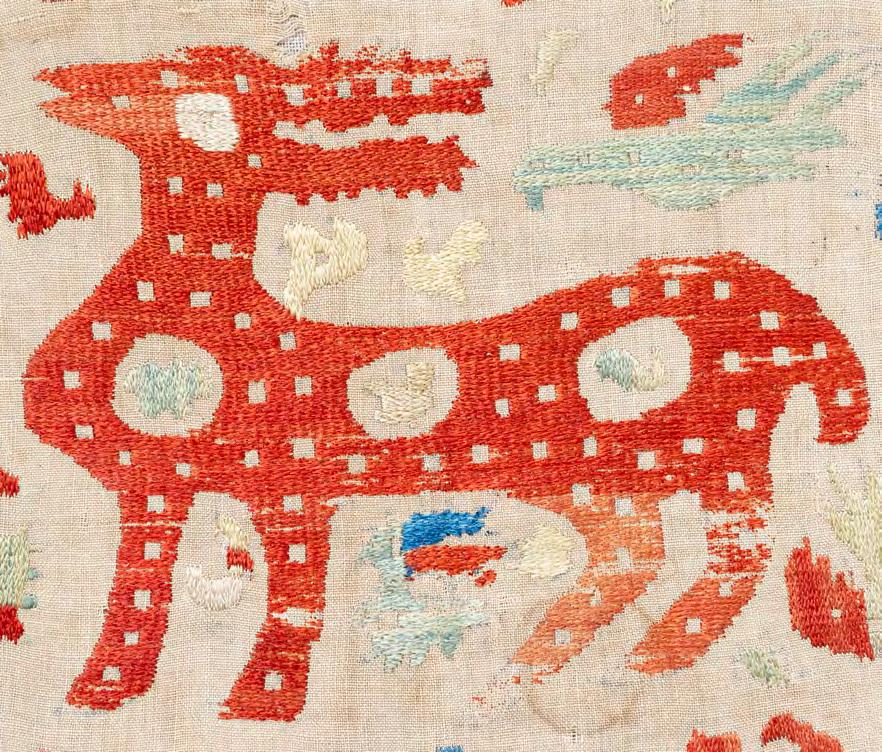
DAGHESTANI APPLIQUÉ
The Republic of Daghestan is located in Central Asia. It is the southernmost part of Russia. Most of Daghestan is mountainous, resulting in a difficult terrain to navigate and interconnect its population. It is one of Russia’s most linguistically and ethnically diverse areas.
Daghestan textiles refer to the recently discovered group of the enigmatic and unique Kaitag embroideries, but there is another group of Daghestani textile to which this textile belong. This group seems to bear influence of neighboring cultures, particularly Shirdaks, the felt floor coverings of Kyrgyzstan and the appliquéd panels of Recht, Iran. They differ from the Shirdaks as they are not made of felt but rather spun wool, and they are too small and delicate to be used as rugs. Recht appliqués on the other hand are much finer.
This example features a blue field with geometrically arranged and highly abstracted floral motifs. They could be pomegranate blossoms or rosettes symbolizing fertility and prosperity. The spaces between them are filled with embroidered pinwheels symbolizing health and longevity. The field is framed by multiple borders, the most striking is a wide twotoned saffron border of meandering branches.
ORIGIN
Daghestan, Russia
PERIOD
18th century
MATERIAL
Wool and silk SIZE
50” x 33”
CONDITION
Very good condition PRICE
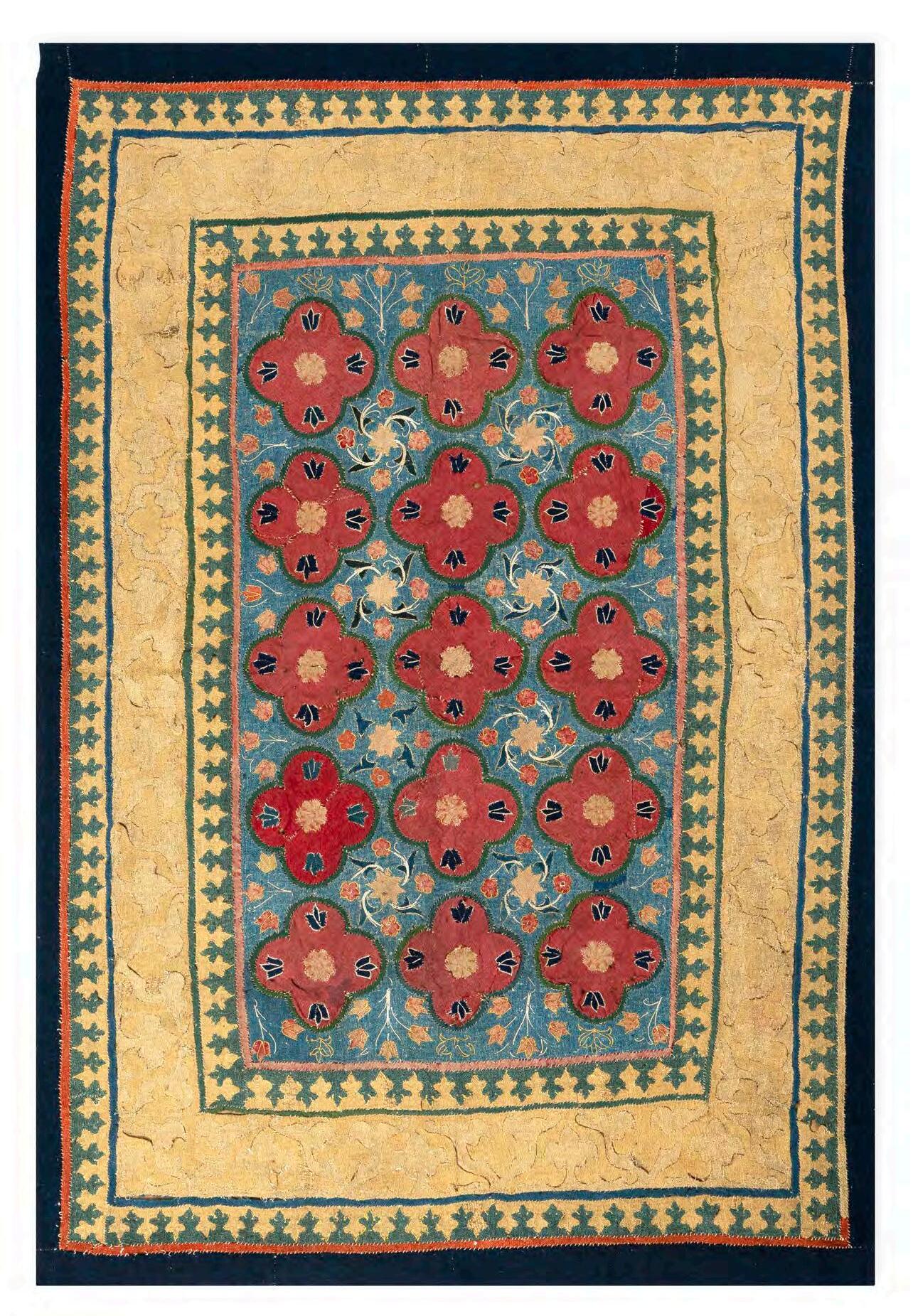
INVENTORY # NS0045

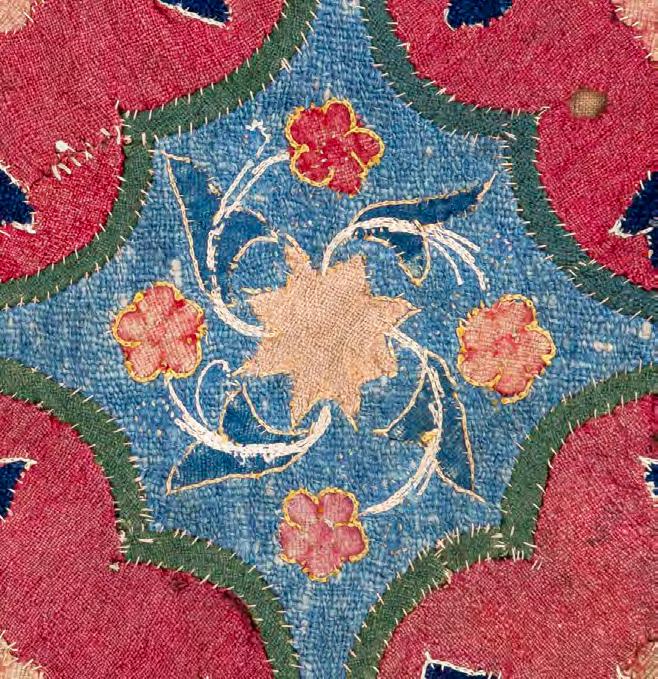


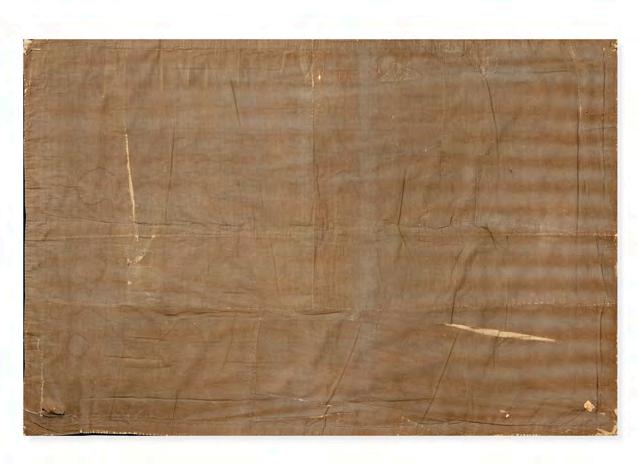
REVERSE VIEW
TAPIS SARONG
Tapis were made in Lampong in southern Sumatra to be used as sarongs and are combined of two horizontal panels sewn together to form a larger square. They are made of silk and cotton in a tight weave in a linear design of natural dyes of mostly earth tones with blue often included. Onto this ground embellishments are added in a variety of forms, mostly of shiny nature such as metallic thread, pieces of mirror or mica and colorful silk.
The metallic thread is embroidered to the ground in a couching technique with thinner thread so as not to damage the ground material and maximize visibility. The motifs of those forms vary, including zoomorphic shapes, alphabet letters, flowers and farm animals, all according to the wearer’s village and clan affiliation.
Tapis sarongs are still used for religious, wedding and welcoming ceremonies. They tend to be opulent as the Lampung people were wealthy traders that benefited from their location along the maritime route to China. As evidenced in this rather outstanding and early piece they liked to display their wealth through textiles and other bodily adornments.
ORIGIN
Lampung, Sumatra
PERIOD
Late 19th–early 20th c
MATERIAL
Cotton, silk, metallic thread and sequins
SIZE
53” x 46”
CONDITION
Very good condition, with minor loss to metallic thread of central bottom flower
PRICE
POR
INVENTORY #
NS0023
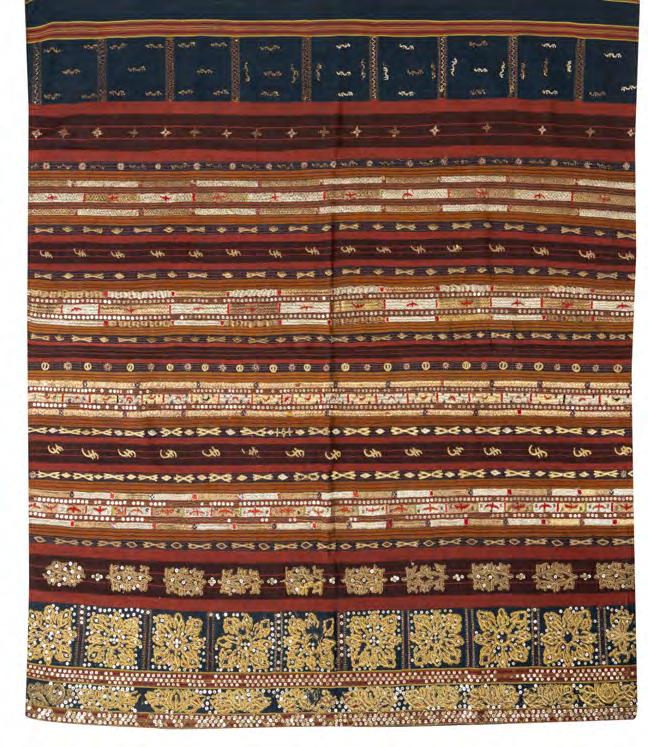

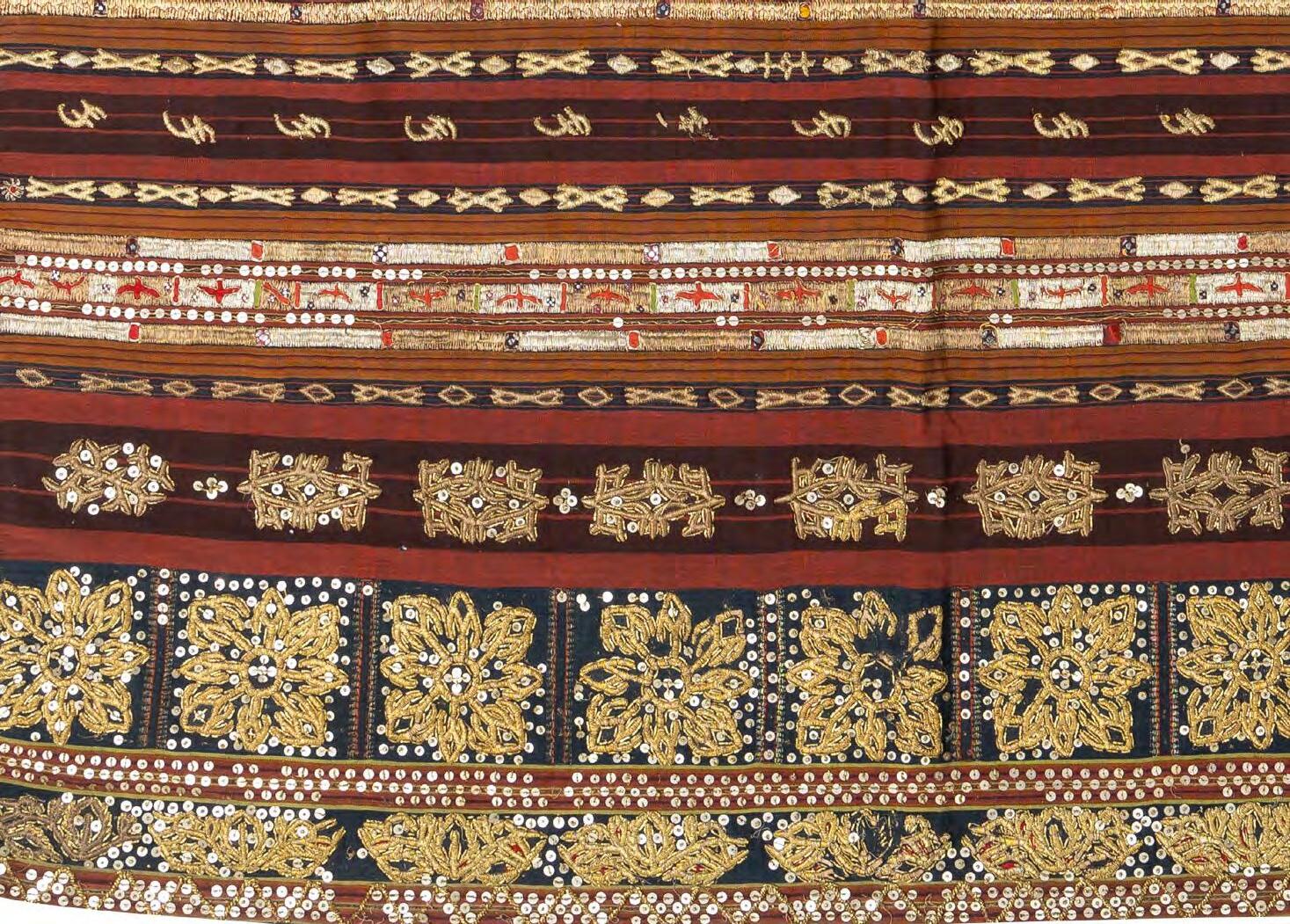
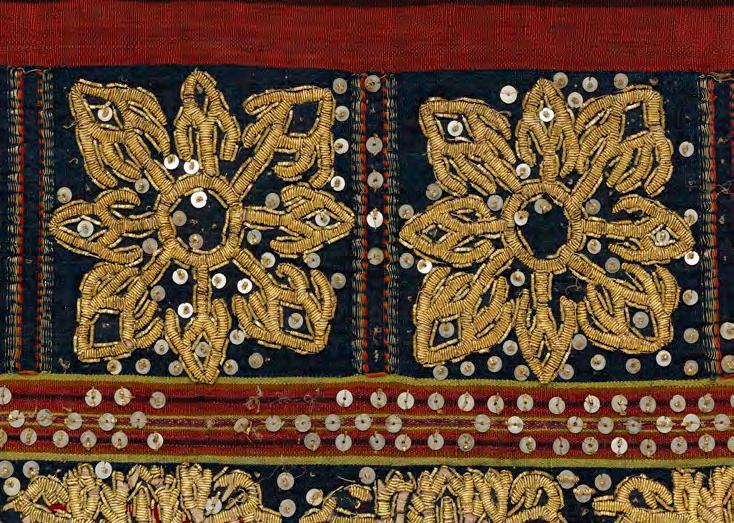

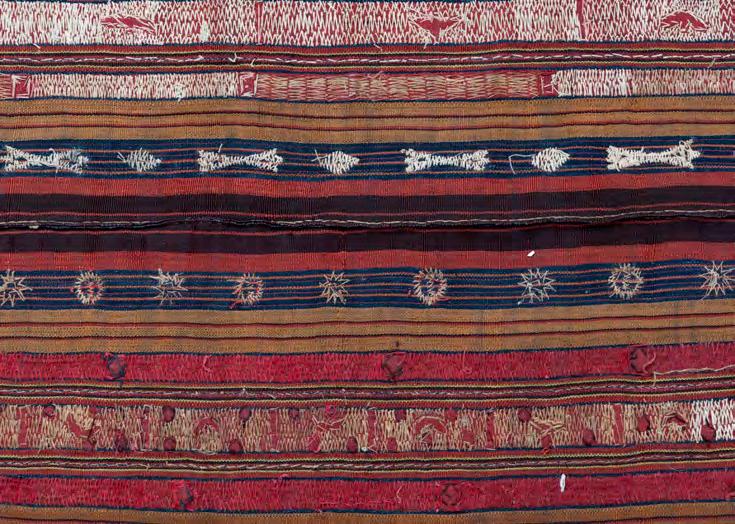
ETHIOPIAN KAFTAN
Ethiopian embroideries can be attributed to two traditions. The Amhara people of the highlands, which are Christians, and their work is influenced by the Coptic Christians of Egypt and the Harar people who are Muslim and live in urban centers and whose work is influenced by India and Saudi Arabia.
Amhara women wear Kemis (chemise) which is a loose-fitting kaftan with wide sleeves such as this fine example. The neck opening is long and usually embellished with tight chain stitch cotton embroidery as are the shoulders. What makes this Kemis unique is the ground which, instead of white cotton, is shiny black satin indicating upper class origin. Also unique are the embroidery motifs which do not feature any traditional Coptic Christian crosses but rather rondel, triangles and stripes all outlined with couched embroidered borders.
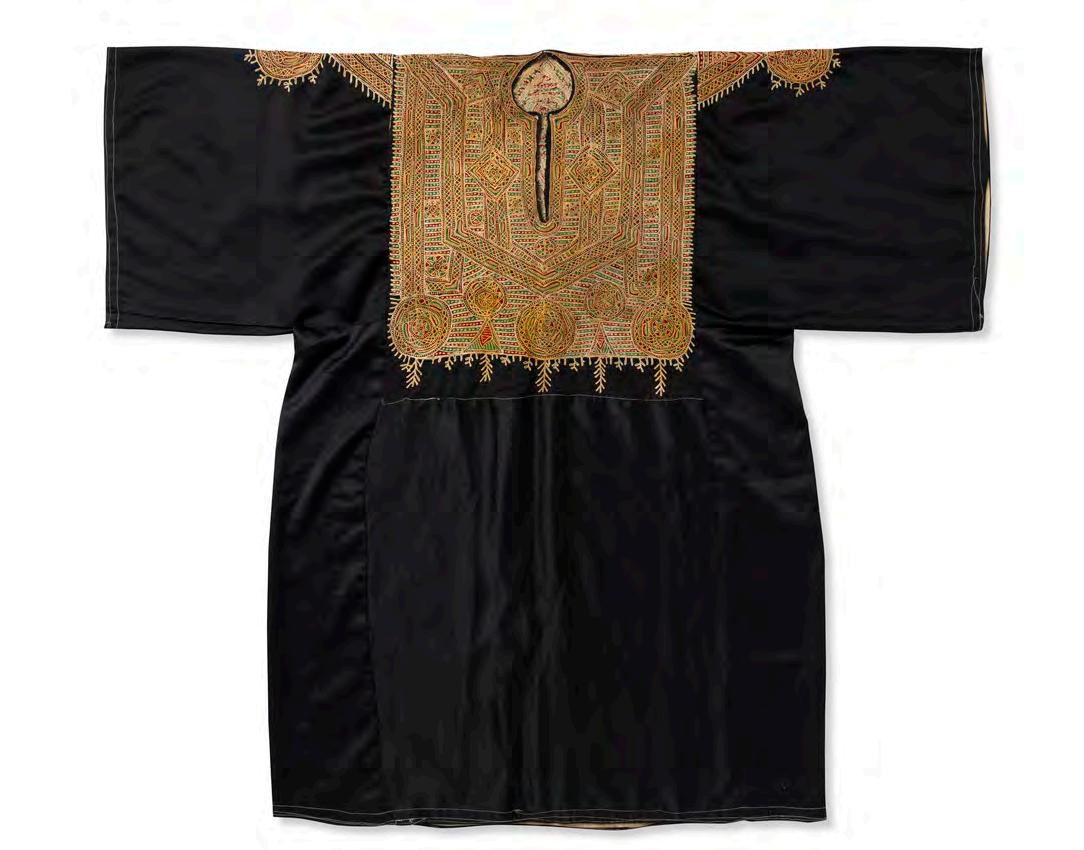
silk with cotton embroidery
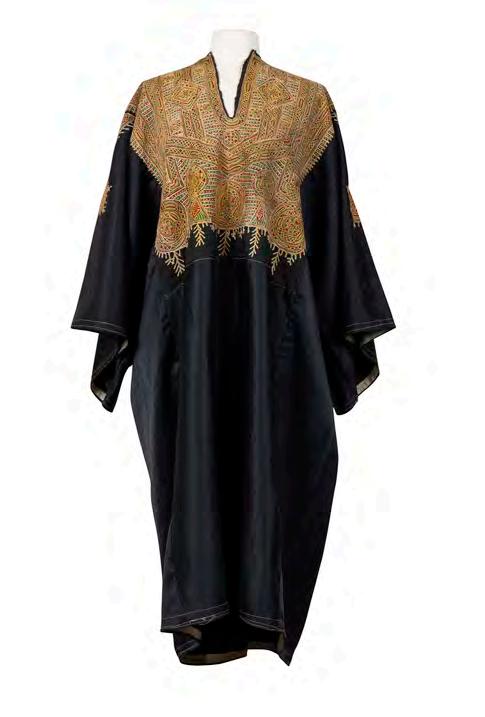
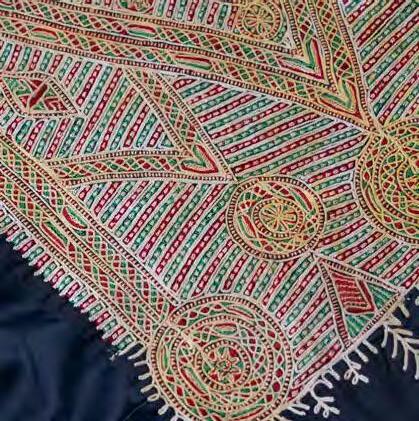
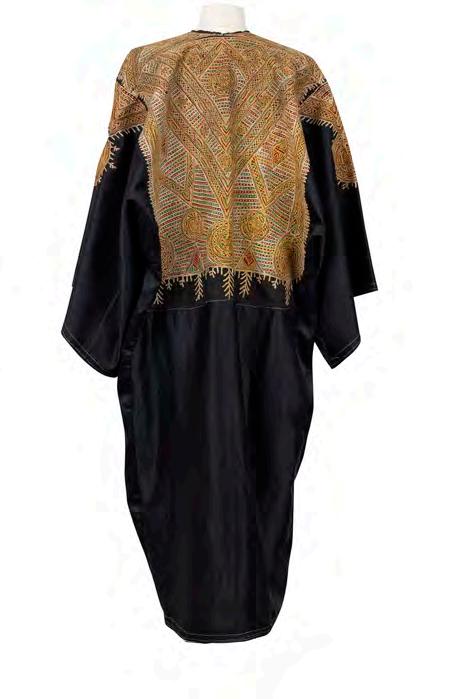


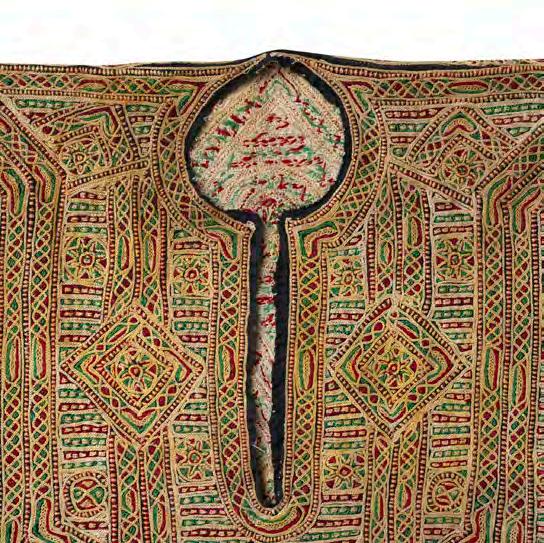
PALESTINIAN THOB
Palestine’s history as a cradle of three religions and position as connection between three continents both contribute to multiple and diverse influences on the local costumes. These influences are less obvious in male costumes which tend to be uniform and more so in female costumes and their decorating motifs.
Palestinian dresses can be divided into three groups. The townspeople which reflected outside influences from Aleppo and Damascus to Europe. The villagers which were the traditional Thobs with their A-line shape, ample proportions, triangular sleeves and square shaped chest piece. These dresses can be easily attributed to specific villages by their embroidered designs. Lastly the Bedouins which were nomads, and their designs reflected tribal origin and not their locality.
This Thob is of urban origins as it is made of silk, an expensive fabric unavailable to the poor villagers. The prominence of couched embroidery points to Bethlehem origin where the couching technique was perfected. The long stripes of alternating crimson red and dark forest green are joined with a beautiful and precise zig zag edging stitch of three alternating colors. The chest square, or the Qubbeh is comprised of concentric squares of different colors that are appliquéd together and embroidered with rosettes amid meandering vines.
ORIGIN
Bethlehem, Palestine
PERIOD
Circa 1900
MATERIAL
Silk and metallic thread embroidery on silk ground
55” x 64”
CONDITION
Minor repairs, uneven fade and small holes to back of neck brocade
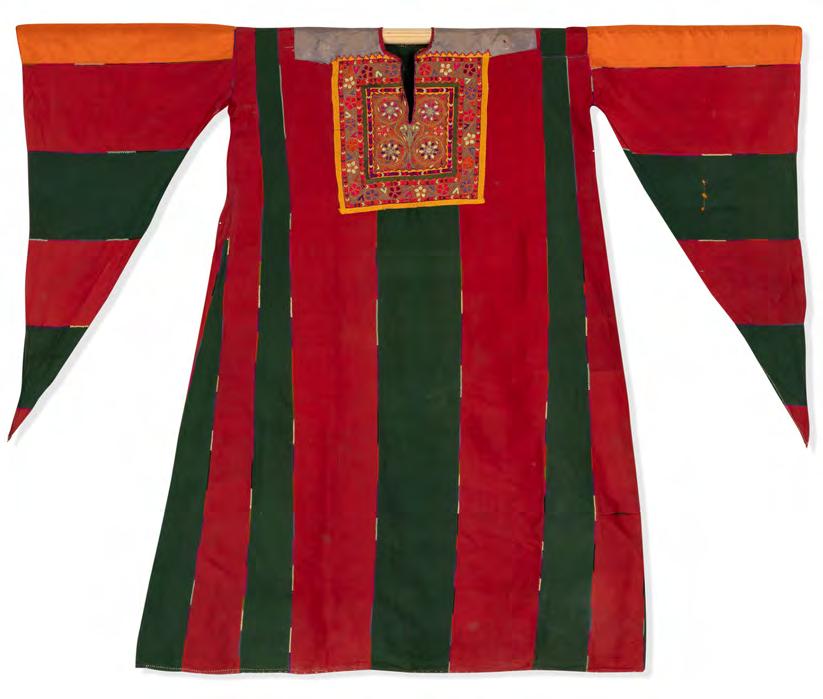
#

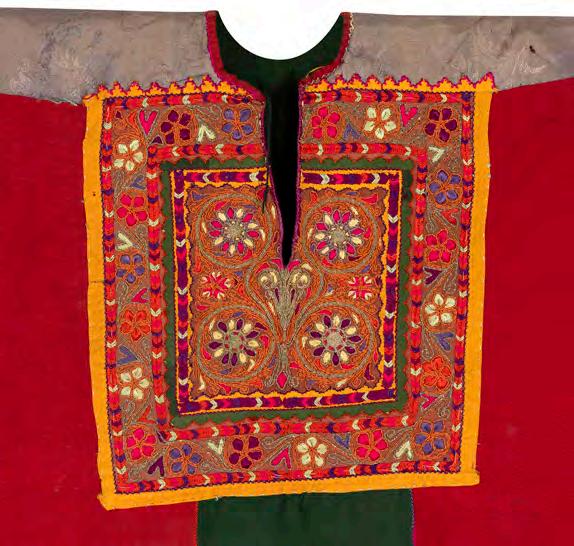
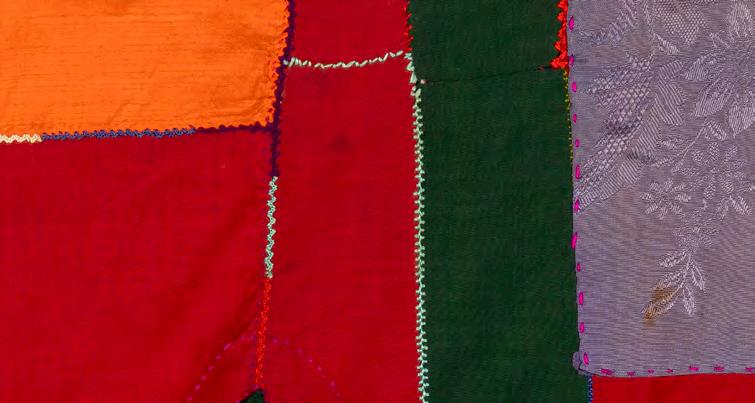
LAMBA AKOTIFAHANA
The island of Madagascar is situated in the Indian Ocean and as such absorbed influence from countries surrounding that ocean. African design elements, Chinese silk and Indonesian garments contribute to a rich textile tradition which is unique.
Lamba Akotifahana is the most iconic of Malagasy textiles. Originally serving dual purposes, Lambas were worn by the living and covered the dead. They were produced in Highland Madagascar by women as far back as the 17th century, reaching popularity in the first half of the 19th century.
Long striped panels of silk decorated with supplementary weft patterning. The shapes created by the supplementary weft can be geometric, figurative or botanical. They, as well as the colors of the stripes, allude to the wearer’s social status.
As Lambas were labor intensive to make they were expensive and worn by the wealthy. Gifted to diplomats and dignitaries they were brought to Europe in the 19th century where they caused quite a sensation due to their vibrant colors and exquisite craftsmanship. A definitive collection of them, which was at the National Museum of the Queen’s Palace in Antananarivo, was destroyed by a fire in the 1990s, rendering them even rarer.
ORIGIN Madagascar
PERIOD
Circa 1890
MATERIAL
Silk with silk brocading
SIZE
86” x 72”
CONDITION
Minor, even fade to pink stripes, good condition
PRICE POR
INVENTORY #
NS0028
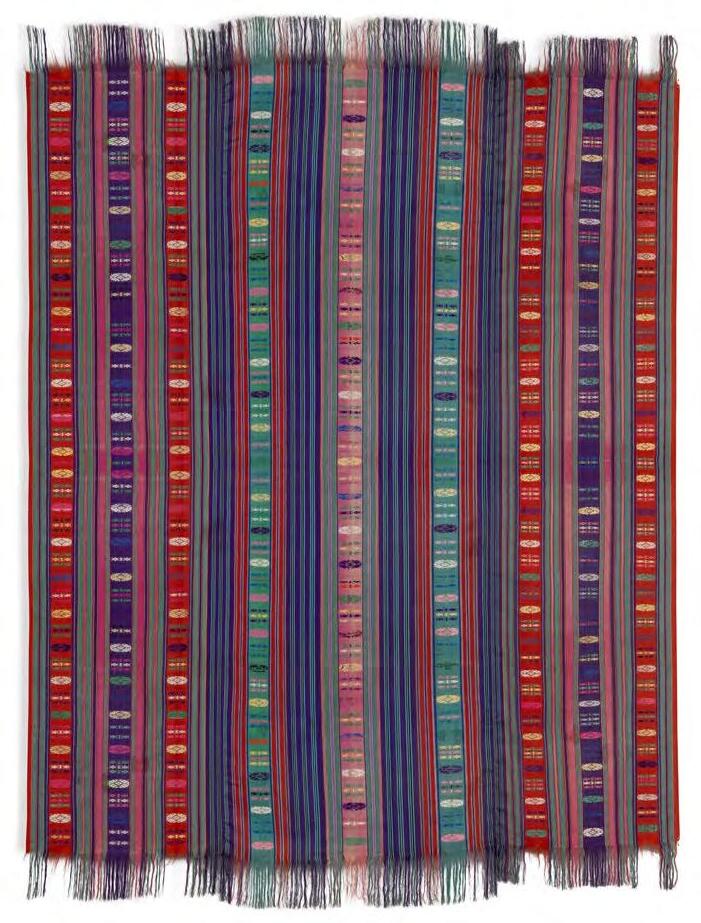


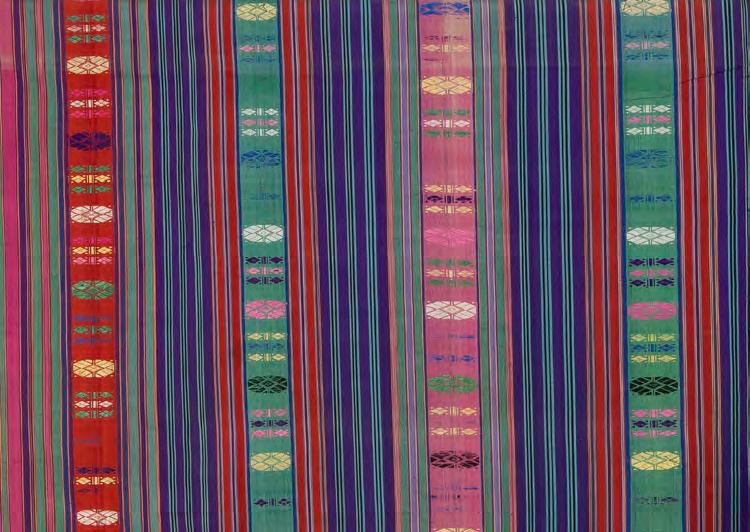
COPTIC MEDALLION
The Copts are the largest Christian community in North Africa, particularly in Egypt where to this day they comprise 15% of the Egyptian population. Coptic textiles exhibit exceptional weaving virtuosity and vibrant colors. They survived because of the dry hot climate and because the Copts buried their dead dressed in them. Most Coptic textiles that survived are tunics that are decorated with long stripes with an emphasis on the shoulders where small medallions were placed to ward off the evil eye. Coptic designs were later a source of inspiration for early Islamic period visual repertoire.
This small square medallion has two wide borders with the blue inner one featuring red flowers, green squares and yellow quatrefoils. The red field has a slender cross with its points ending in trefoils. All executed in tapestry weave and retaining vibrant vegetal dyes.


